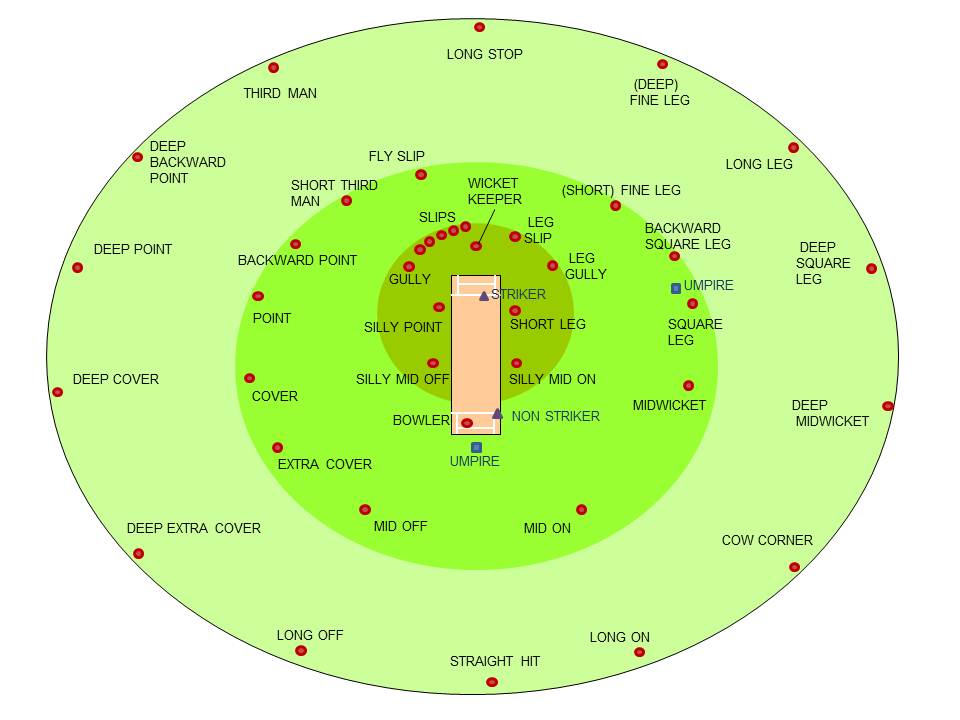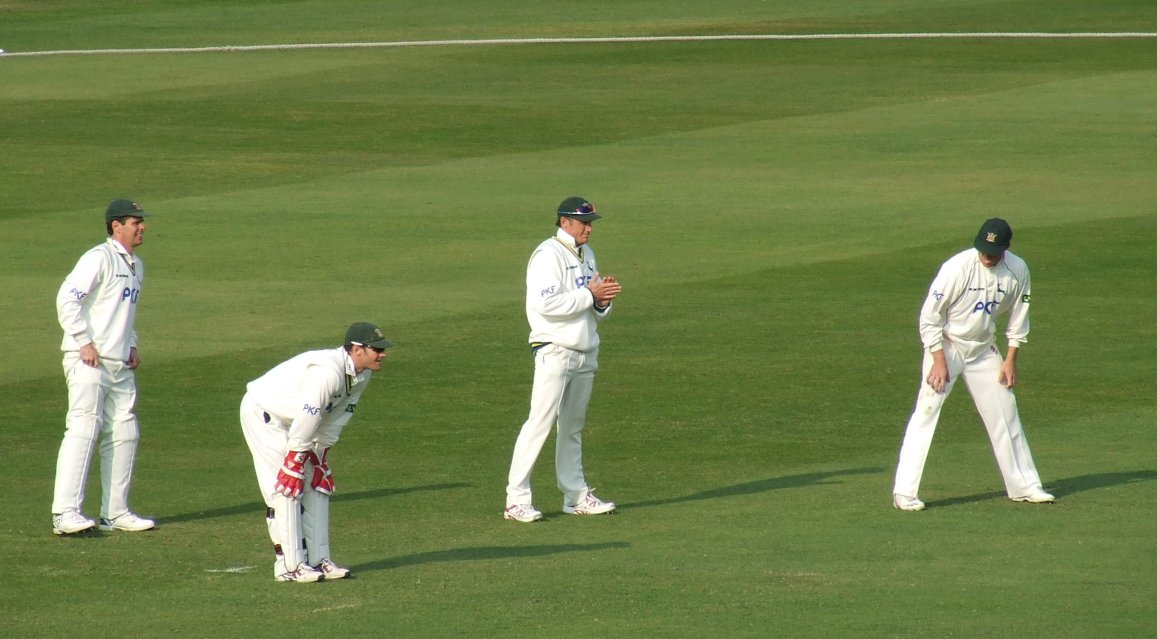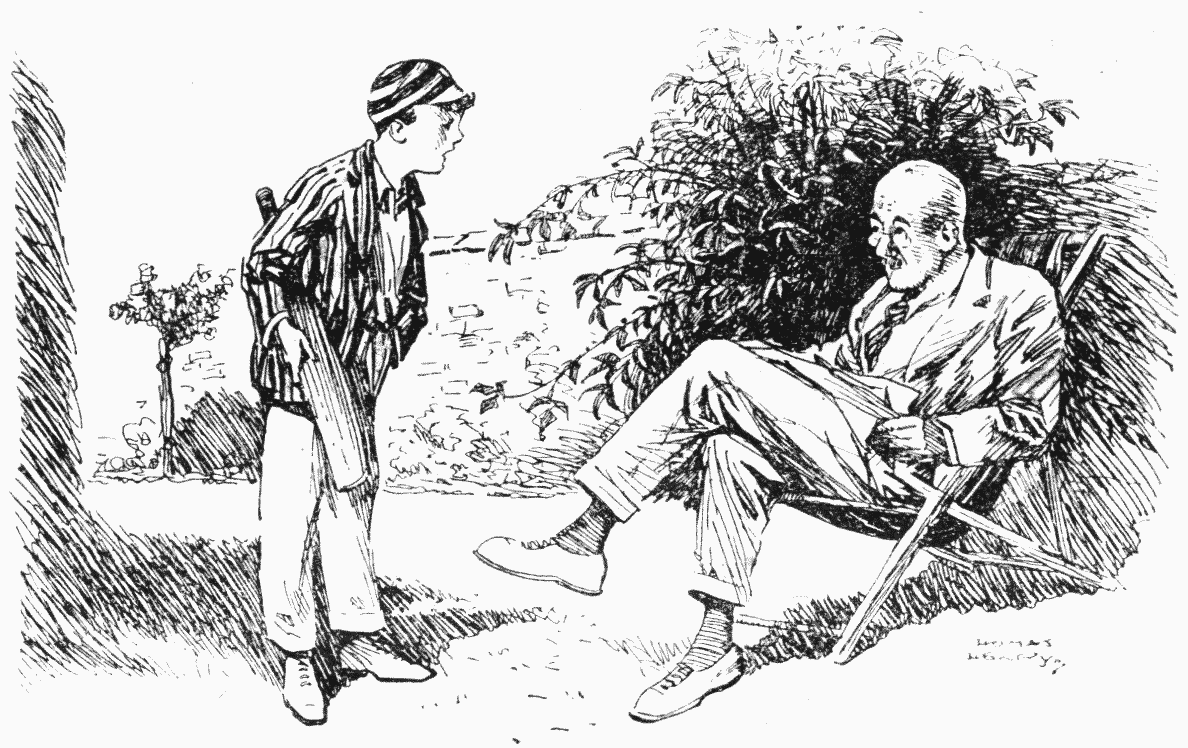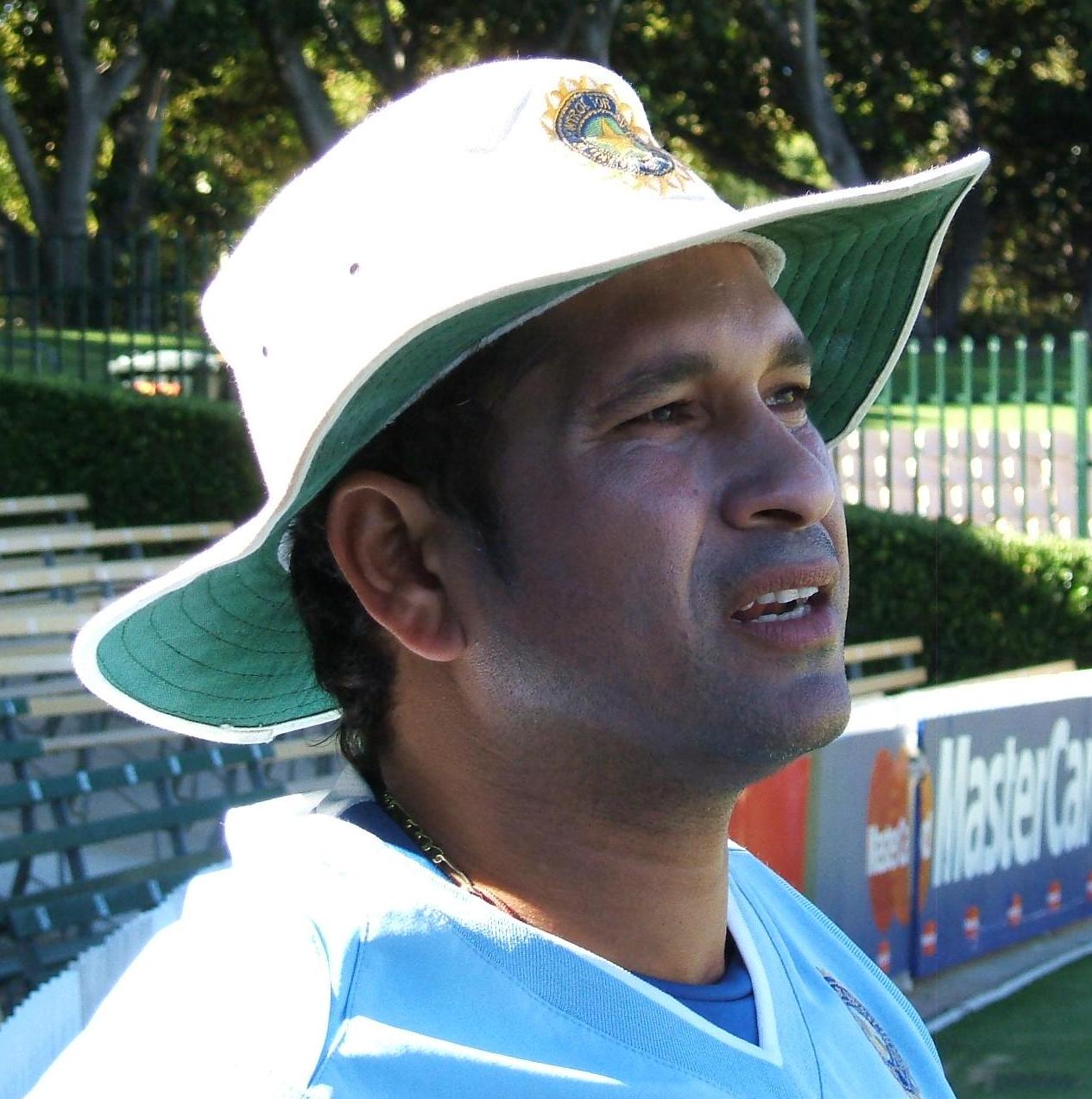|
Cow Corner (cricket)
Cow corner is a region of the field in cricket. The location of cow corner depends on a batsman's handedness, but it is always a part of the field in the deep on the batsman's leg side, typically stretching between deep-midwicket and long on. The diagram shows the location of cow corner for a right-handed batsman. Cow corner is thought to be named after an area on the ground at Dulwich College where cattle would often graze. This has led to the naming of ''Cow shots'', which are wild and risky shots that tend to end up at cow corner, and are considered to be mostly played by players with little knowledge of, or ability to apply, the more difficult techniques of the game. Such players were supposed to be particularly prominent in the type of cricket played in rural or agricultural areas, where players did not have exposure to more sophisticated methods of playing. Such shots are also called agricultural. This region of the field has been somewhat more frequented in more recent ... [...More Info...] [...Related Items...] OR: [Wikipedia] [Google] [Baidu] |
Cricket Field
A cricket field is a large grass field on which the game of cricket is played. Although generally oval in shape, there is a wide variety within this: some are almost perfect circles, some elongated ovals and some entirely irregular shapes with little or no symmetry – but they will have entirely curved boundaries, almost without exception. There are no fixed dimensions for the field but its diameter usually varies between 450 feet (137 m) and 500 feet (150 m) for men's cricket, and between and for women's cricket. Cricket is unusual among major sports (along with golf, Australian rules football and baseball) in that there is no official rule for a fixed-shape ground for professional games. On most grounds, a rope demarcates the perimeter of the field and is known as the '' boundary''. Within the boundary and generally as close to the centre as possible will be the ''square'' which is an area of carefully prepared grass upon which cricket pitches can be pr ... [...More Info...] [...Related Items...] OR: [Wikipedia] [Google] [Baidu] |
Cricket
Cricket is a bat-and-ball game played between two teams of eleven players on a field at the centre of which is a pitch with a wicket at each end, each comprising two bails balanced on three stumps. The batting side scores runs by striking the ball bowled at one of the wickets with the bat and then running between the wickets, while the bowling and fielding side tries to prevent this (by preventing the ball from leaving the field, and getting the ball to either wicket) and dismiss each batter (so they are "out"). Means of dismissal include being bowled, when the ball hits the stumps and dislodges the bails, and by the fielding side either catching the ball after it is hit by the bat, but before it hits the ground, or hitting a wicket with the ball before a batter can cross the crease in front of the wicket. When ten batters have been dismissed, the innings ends and the teams swap roles. The game is adjudicated by two umpires, aided by a third umpire and match r ... [...More Info...] [...Related Items...] OR: [Wikipedia] [Google] [Baidu] |
Handedness
In human biology, handedness is an individual's preferential use of one hand, known as the dominant hand, due to it being stronger, faster or more dextrous. The other hand, comparatively often the weaker, less dextrous or simply less subjectively preferred, is called the non-dominant hand. In a study from 1975 on 7688 children in US grades 1-6, Left handers comprised 9.6% of the sample, with 10.5% of male children and 8.7% of female children being left-handed. Handedness is often defined by one's writing hand, as it is fairly common for people to prefer to do some tasks with each hand. There are examples of true ambidexterity (equal preference of either hand), but it is rare—most people prefer using one hand for most purposes. Most of the current research suggests that left-handedness has an epigenetic marker—a combination of genetics, biology and the environment. Because the vast majority of the population is right-handed, many devices are designed for use by right-h ... [...More Info...] [...Related Items...] OR: [Wikipedia] [Google] [Baidu] |
Fielding (cricket)
Fielding in the sport of cricket is the action of fielders in collecting the ball after it is struck by the striking batter, to limit the number of runs that the striker scores and/or to get a batter out by either catching a hit ball before it bounces, or by running out either batter before they can complete the run they are currently attempting. There are a number of recognised fielding positions, and they can be categorised into the offside and leg side of the field. Fielding also involves preventing the ball from going to or over the edge of the field (which would result in runs being scored by the batting team in the form of a boundary). A ''fielder'' or ''fieldsman'' may field the ball with any part of his body. However, if while the ball is in play he wilfully fields it otherwise (e.g. by using his hat), the ball becomes dead and five penalty runs are awarded to the batting side, unless the ball previously struck a batter not attempting to hit or avoid the ba ... [...More Info...] [...Related Items...] OR: [Wikipedia] [Google] [Baidu] |
Leg Side
The leg side, or on side, is defined to be a particular half of the field used to play the sport of cricket. It is the side of the field that corresponds to the batsman's non-dominant hand, from their perspective. From the point of view of a right-handed batsman facing the bowler, it is the left hand side of the cricket field (being to the bowler's right). With a left-handed batsman the on side is to the batsman's right (and to the bowler's left). A cricket field is notionally divided into two halves, by an imaginary line running down the long axis of the pitch. In normal batting stance, the striking batsman stands side on to the bowler. The leg side is the half of the field ''behind'' the batsman. The half of the field in front of him is called the off side. In the picture, the bowler is bowling from the bottom half of the image, the right-handed batsman (S), facing him sideways on, has his legs more on the right side of the picture, the ''leg-side''. If the ball goes down th ... [...More Info...] [...Related Items...] OR: [Wikipedia] [Google] [Baidu] |
Dulwich College
Dulwich College is a 2–19 independent, day and boarding school for boys in Dulwich, London, England. As a public school, it began as the College of God's Gift, founded in 1619 by Elizabethan actor Edward Alleyn, with the original purpose of educating 12 poor scholars. It began to grow into a large school from 1857, and took its current form in 1870 when it moved into its current premises. Admission by examination is mainly into years 3, 7, 9, and 12 (i.e. ages 7, 11, 13, and 16 years old) to the Junior, Lower, Middle and Upper Schools into which the college is divided. It is a member of both the Headmasters' and Headmistresses' Conference and the Eton Group. History 1619: The College of God's Gift On 21 June 1619 the College of God's Gift was established in Dulwich by Edward Alleyn with the signing letters patent by James I.Hodges, S. (1981), ''God's Gift: A Living History of Dulwich College'', pp. 3–5 (Heinemann: London). The term "Dulwich College" was used coll ... [...More Info...] [...Related Items...] OR: [Wikipedia] [Google] [Baidu] |
Yorker
In cricket, a yorker is a ball bowled (a delivery) which hits the cricket pitch around the batsman's feet. When a batsman assumes a normal stance, this generally means that the cricket ball bounces on the cricket pitch on or near the batsman's popping crease. A batsman who advances down the pitch to strike the ball (typically to slower or spin bowlers) may by so advancing cause the ball to pitch (or land) at or around his feet and may thus cause himself to be "yorked". Yorkers are considered to be one of the most difficult deliveries to bowl for the bowlers. Etymology The ''Oxford English Dictionary'' gives the derivation of the term as originating in Yorkshire, a notable English cricketing county. According to Oxford dictionaries, the term was coined because players from York bowled these deliveries. Another theory attributes the name to the other meaning of yorker which is a cheater. However, other derivations have been suggested. The term may derive from the 18th and ... [...More Info...] [...Related Items...] OR: [Wikipedia] [Google] [Baidu] |
Cricket Terminology
This is a general glossary of the terminology used in the sport of cricket. Where words in a sentence are also defined elsewhere in this article, they appear in italics. Certain aspects of cricket terminology are explained in more detail in cricket statistics and the naming of fielding positions is explained at fielding (cricket). Cricket is known for its rich terminology.''Glossary of cricket terms'' from the England Cricket Board retrieved 13 May 2008Cricket Academy – Glossary from [...More Info...] [...Related Items...] OR: [Wikipedia] [Google] [Baidu] |
Leg Side
The leg side, or on side, is defined to be a particular half of the field used to play the sport of cricket. It is the side of the field that corresponds to the batsman's non-dominant hand, from their perspective. From the point of view of a right-handed batsman facing the bowler, it is the left hand side of the cricket field (being to the bowler's right). With a left-handed batsman the on side is to the batsman's right (and to the bowler's left). A cricket field is notionally divided into two halves, by an imaginary line running down the long axis of the pitch. In normal batting stance, the striking batsman stands side on to the bowler. The leg side is the half of the field ''behind'' the batsman. The half of the field in front of him is called the off side. In the picture, the bowler is bowling from the bottom half of the image, the right-handed batsman (S), facing him sideways on, has his legs more on the right side of the picture, the ''leg-side''. If the ball goes down th ... [...More Info...] [...Related Items...] OR: [Wikipedia] [Google] [Baidu] |
Batting (cricket)
In cricket, batting is the act or skill of hitting the ball with a bat to score runs and prevent the loss of one's wicket. Any player who is currently batting is, since September 2021, officially referred to as a batter (historically, the terms "batsman" and "batswoman" were used), regardless of whether batting is their particular area of expertise. Batters have to adapt to various conditions when playing on different cricket pitches, especially in different countries - therefore, as well as having outstanding physical batting skills, top-level batters will have quick reflexes, excellent decision-making and be good strategists. During an innings two members of the batting side are on the pitch at any time: the one facing the current delivery from the bowler is called the striker, while the other is the non-striker. When a batter is out, he is replaced by a team-mate. This continues until the end of the innings, which in most cases is when 10 of the team members are out, w ... [...More Info...] [...Related Items...] OR: [Wikipedia] [Google] [Baidu] |







